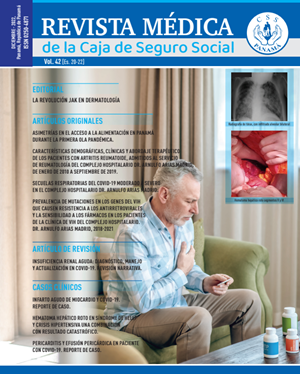Respiratory sequel of moderate to severe covid-19 in Dr. Arnulfo Arias Madrid Hospital Complex, Panama
Main Article Content
Abstract
Introduction
SARS-Cov-2 has caused a large number of infections with variable symptoms. Prior to vaccination, 15 % of those infected required hospitalization, and long-term respiratory symptoms are described in these group. The objective of the study was to determine the persistence of pulmonary alterations after 12 months of hospitalization.
Methodology
We conducted an observational, descriptive, cross-sectional, and prospective study over a sample of patients hospitalized for COVID-19 that had used supplemental oxygen at the Dr. Arnulfo Arias Madrid Hospital Complex between April and August 2020. Prior informed consent, general variables, persistent respiratory symptoms, pulmonary function data and persistence of radiographic infiltrates at 12 months after hospitalization were registered. Evaluated and approved by the National Bioethics and Research Committee and registered with the code EC-CNBI-2020-09-95.
Results
A total of 28 patients with an average age of 55 years (33-83) were studied, mainly female with 60.71 %. 60.71 % without previous comorbidities; 32.14 % reported non-pulmonary comorbidities, 17.86 % pulmonary diseases. The most frequent symptom was cough with 35.71 %, followed by dyspnea with 32.14 %; 25 % presented decreased forced vital capacity and 57.14 % no longer had alterations in radiographic studies.
Conclusions
Cough, dyspnea and decreased forced vital capacity were the most frequent findings in the sample. Regarding imaging findings, reticular infiltrates were the most common.
Downloads
Article Details
Issue
Section

This work is licensed under a Creative Commons Attribution-NonCommercial 4.0 International License.
How to Cite
References
1. Jin Y, Yang H, Ji W, Wu W, Chen S, Zhang W, et. al. Virology, Epidemiology, Pathogenesis, and Control of COVID-19. Viruses. 2020;12:372.
2. Venkataraman T, Frieman MB. The role of epidermal growth factor receptor (EGFR) signaling in SARS coronavirus-induced pulmonary fibrosis. Antiviral Res. 2017;143:142-50.
3. Wong HYF, Lam HYS, Fong AH, Leung ST, Chin TW, Lo CSY, et. al. Frequency and Distribution of Chest Radiographic Findings in Patients Positive for COVID-19. Radiology. 2020;296:E72-E78.
4. Salehi S, Abedi A, Balakrishnan S, Gholamrezanezhad A. Coronavirus Disease 2019 (COVID-19): A Systematic Review of Imaging Findings in 919 Patients. AJR Am J Roentgenol. 2020;215:87-93.
5. Hui DS, Wong KT, Ko FW, Tam LS, Chan DP, Woo J, et. al. The 1-year impact of severe acute respiratory syndrome on pulmonary function, exercise capacity, and quality of life in a cohort of survivors. Chest. 2005;128:2247-61.
6. Lechowicz K, Drożdżal S, Machaj F, Rosik J, Szostak B, Zegan-Barańska M, et. al. COVID-19: The Potential Treatment of Pulmonary Fibrosis Associated with SARS-CoV-2 Infection. J Clin Med. 2020;9:1917.
7. Yu M, Liu Y, Xu D, Zhang R, Lan L, Xu H. Prediction of the Development of Pulmonary Fibrosis Using Serial ThinSection CT and Clinical Features in Patients Discharged after Treatment for COVID-19 Pneumonia. Korean J Radiol. 2020;21:746-55.
8. George, P. M., Wells, A. U., & Jenkins, R. G. Pulmonary fibrosis and COVID-19: the potential role for antifibrotic therapy. Lancet Respir Med 2020;8:807–15.
9. Jennings G, Monaghan A, Xue F, Mockler D, RomeroOrtuño R. A Systematic Review of Persistent Symptoms and Residual Abnormal Functioning following Acute COVID-19: Ongoing Symptomatic Phase vs. PostCOVID-19 Syndrome. J Clin Med. 2021;10:5913.
10. Nasserie T, Hittle M, Goodman SN. Assessment of the Frequency and Variety of Persistent Symptoms Among Patients With COVID-19: A Systematic Review. JAMA Netw Open. 2021;4:e2111417.
11. Zhang X, Wang F, Shen Y, Zhang X, Cen Y, Wang B. Symptoms and Health Outcomes Among Survivors of COVID-19 Infection 1 Year After Discharge From Hospitals in Wuhan, China. JAMA Netw Open. 2021;4:e2127403.
12. Huang C, Huang L, Wang Y, Xia L, Lili R, Gu X, et al. 6-month consequences of COVID-19 in patients discharged from hospital: a cohort study. Lancet. 2021;397:220-32.
13. Damanti S, Ramirez GA, Bozzolo EP, Rovere-Querini P, De Lorenzo R, Magnaghi C, et. al. Six-month respiratory outcomes and exercise capacity of COVID-19 acute respiratory failure patients treated with continuous positive airway pressure. Intern Med J. 2021;51:1810-5.
14. Zangrillo A, Belletti A, Palumbo D, Calvi M, Guzzo, F, Fominskiy E, et al. One-Year Multidisciplinary FollowUp of Patients With COVID-19 Requiring Invasive Mechanical Ventilation. J Cardiothorac Vasc Anesth. 2022;36:1354-63.
15. Daher A, Cornelissen C, Hartmann NU, Balfanz P, Müller A, Bergs I, et al. Six Months Follow-Up of Patients with Invasive Mechanical Ventilation due to COVID-19 Related ARDS. Int J Environ Res Public Health. 2021;18:5861.
16. Moreno-Pérez O, Merino E, Leon-Ramirez JM, Mariano A, Ramos J, Arenas J, et al. Post-acute COVID-19 syndrome. Incidence and risk factors: A Mediterranean cohort study. J Infect. 2021;82:378-83.
17. O’Brien K, Townsend L, Dowds J, Bannan C, Nadarajan P, Kent B, et. al. 1-year quality of life and healthoutcomes in patients hospitalised with COVID-19: a longitudinal cohort study. Respir Res. 2022;23:115.
18. Bardakci MI, Ozturk EN, Ozkarafakili MA, Ozkurt H, Yanc U, Yildiz Sevgi D. Evaluation of long-term radiological findings, pulmonary functions, and health-related quality of life in survivors of severe COVID-19. J Med Virol. 2021;93:5574-81.
19. Blanco JR, Cobos-Ceballos MJ, Navarro F, Sanjoaquin I, Arnaiz F, Bernal E, et al. Pulmonary long-term consequences of COVID-19 infections after hospital discharge. Clin Microbiol Infect. 2021;27(6):892-6.
20. Steinbeis F, Thibeault C, Doellinger F, Ring R, Mittermaier M, Ruwwe-Glosenkamp C, et al. Severity of respiratory failure and computed chest tomography in acute COVID-19 correlates with pulmonary function and respiratory symptoms after infection with SARSCoV-2: An observational longitudinal study over 12 months. Respir Med. 2022;191:106709.
21. Sánchez C. Función pulmonar y frecuencia de síndrome post-COVID-19 en pacientes recuperados de neumonía por SARS-CoV-2 mediante enfoque completo de telemedicina. Respirar. 2021:13:128.

